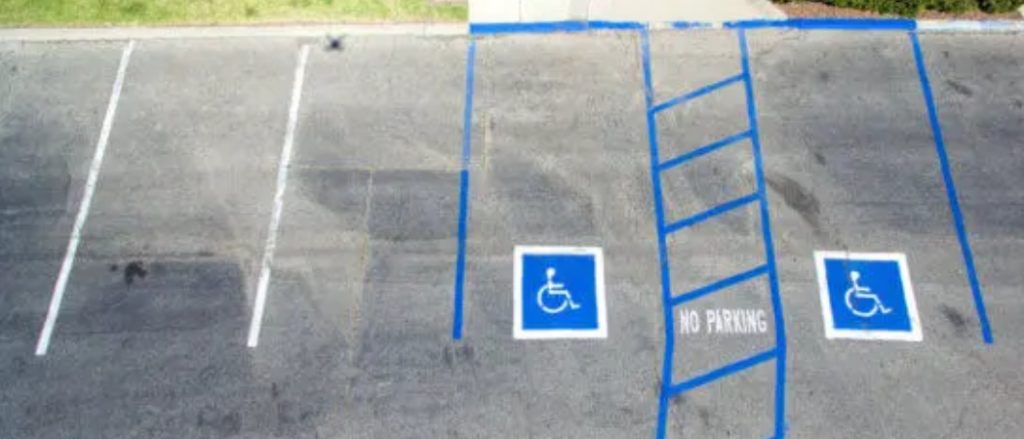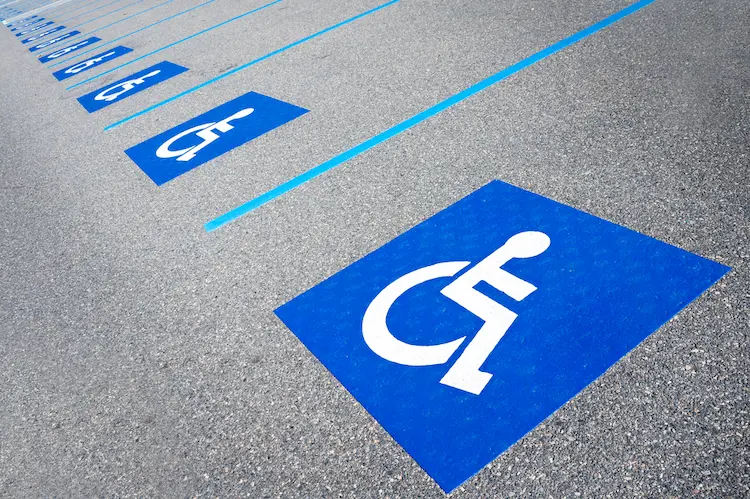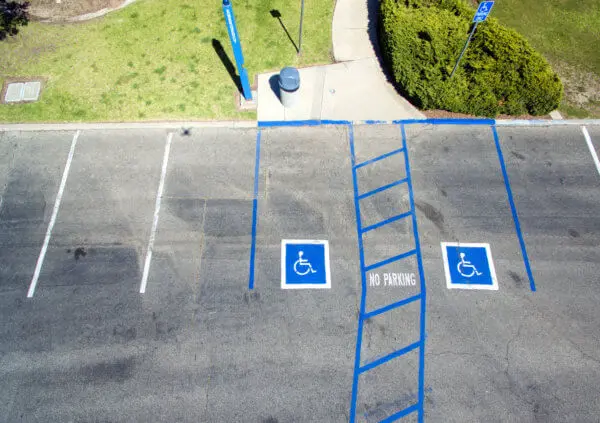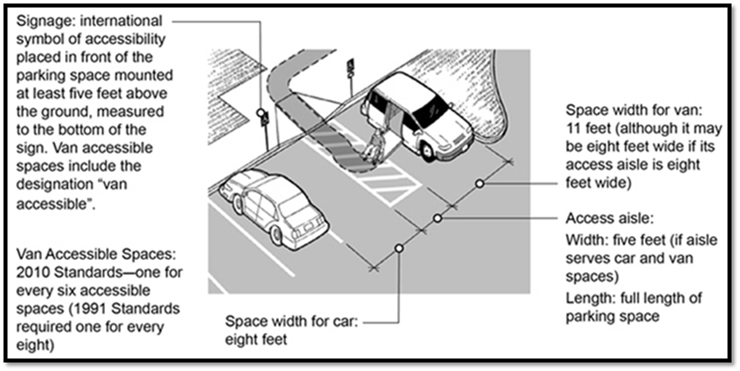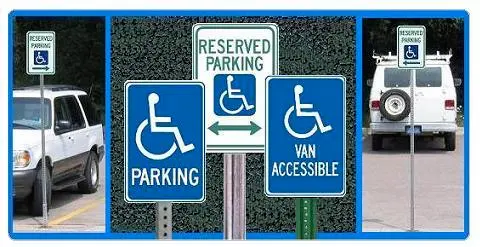The blue and white wheelchair representation on a parking spot is common in supermarkets, shopping centers, and apartment buildings, but have you ever considered the vital function these signs play?
These signs designate parking spaces for the disabled. With 26% of Americans living with a disability, it is essential to create accessible spaces so people with disabilities have the same access to businesses, public buildings, and services as everyone else.
Our article will include all you need to know about these parking spaces and the federal guidelines that make it simpler for the disabled to move around with the help of accessible parking spaces.
But first, let’s define accessible parking space.
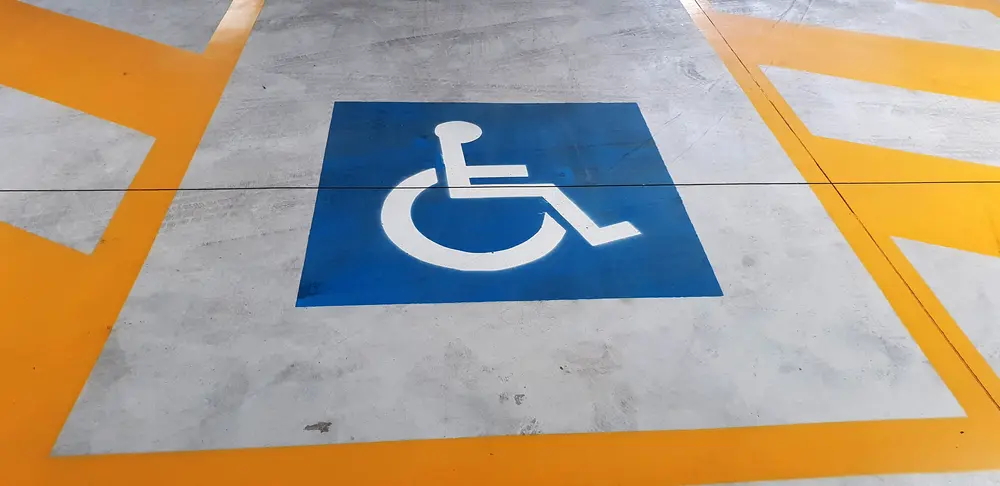
What are Handicapped or Accessible Parking Spaces?
Handicap parking spaces are designated areas within, on the street, or in any other place reserved for disabled people.
These are different from standard parking spots. They are exclusively designed with features that allow people with disabilities to have easy access to their car, and parking in these spaces is restricted to vehicles displaying a valid disability parking placard or license plate, which gives them the right to park in any accessible parking space.
In addition, accessible parking spots are typically closer to the building’s main entrance (whether a grocery store, a health club, a movie theater, or something else).
The Importance Of Accessible Parking Spaces
These accessible parking spaces are more than just defined pavement; they symbolize a dedication to welcoming and including people of every generation and physical ability. Some other benefits of these parking spaces are mentioned below.
Equality
Providing accessible parking spots shows dedication to ensuring that people of all abilities can access public and private places, which helps to equalize the odds for individuals with mobility issues.
Promotes Independence
Adaptive technologies and vehicle modifications allow many people with disabilities to continue driving independently, including people with paraplegia. The availability of accessible parking spots improves disabled people’s quality of life. It will enable them to go about their everyday lives, such as doctor visits, social events, and grocery shopping, with greater freedom and autonomy.
Oz shares his experience of accessing a handicapped placard, including the ease of accessible parking.
Proximity to Facilities
Parking spots for those with mobility impairments are close to buildings and other facilities, which is helpful for individuals with mobility restrictions since it reduces the effort required to reach the building.
Raise Awareness
Disabled people’s needs are better understood and respected when society provides them with designated accessible parking spots. It can increase people’s capacity for empathy and understanding, leading to more welcoming and accepting communities.
It also has a domino effect, causing other businesses in the area to become more user-friendly. Making the world a better place for everyone takes a group effort.
Room To Maneuver
These handicapped parking places are also designed to give drivers and passengers more space to maneuver around a vehicle and to set up and take down mobility aids like wheelchairs and walkers.
Regulations and Guidelines for Accessible Parking Space
The ADA specifies in great detail the requirements for disabled parking facilities. Suitable stall sizes, markings, and slot positions must be considered and followed to be completely compatible with handicap-accessible parking standards and regulations.
Here are a few of the most essential aspects of ADA-compliant parking lots.
Location
Parking spots for the disabled should be placed as close as possible to an entrance that is easily accessible. It may not necessarily refer to the parking spaces that are most proximate to the building but rather those that provide the most convenient access to its entrance.
For multiple entries, spaces should be distributed among each access and located nearest to it. For example, A shopping complex includes fifteen stores, each with its entrance. There is one major parking lot with 1,000 spaces. The twenty accessible parking places should be scattered to give visitors multiple options for parking near the various sites.
An accessible path has no obstacles like curbs, steps, or unstable or slippery surfaces, and its slope does not exceed 1:12 (one inch of rise for every 12 inches of distance walked).
This video describes the significance of a level-accessible parking space and gives an example of an unsafe scenario with a steep cross slope.
Space Requirement
ADA parking space requirements ensure that all parking spots and aisles must have an appropriate width for those using wheelchairs or mobility aids.
The width of accessible parking spaces is 8 feet( 96 inches), while van-accessible spaces are 11 feet (132 inches) and have a 60-inch access aisle adjacent to the parking space leading to a ramp or entryway. Two spaces may share a single-access aisle.
The aisle must be located on the passenger side. Additionally, these areas should have a vertical clearance of 98 inches.
Victor Felix, an ADA Compliance Specialist, demonstrates how to measure accessible parking spaces and discusses the relevant laws.
Standards for Access Aisles
All accessible spaces should have an adjacent access aisle to facilitate mobility for individuals with disabilities. The access aisle connects the parking space to the building’s accessible entrance.
These access aisles are always 5 feet (60 inches) wide. An alternate design permits a van-accessible space to be eight (8) feet wide if the neighboring access aisle is also eight (8) feet wide.
There are regulations for access aisles, such as
- Placement: Accessible spaces may share access aisles, but each space must have at least one access aisle. Angled van-accessible parking spaces necessitate a passenger-side access aisle.
- Routes: Access aisles should connect parking spaces to accessible routes, which must be at least 3 feet wide and equipped with a ramp rather than curbs or stairs. The ramp should not obstruct the aisle space; its highest elevation should measure 36 inches.
- Markings: Access aisles must be marked (e.g., with hatch marks) so that parking is discouraged by other people.
Remember that the access aisle is essential, enabling individuals with wheelchairs and other mobility devices to enter and exit their vehicles in the parking lot.
Parking Spaces Types
The Americans with Disabilities Act (ADA) parking regulations were last revised in 2010 and specify the minimum number of standard handicapped parking spots and van parking spaces that must be provided at any particular location, in addition to additional technical standards. But there can be two kinds of parking spaces provided by any facility,
Standard Accessible Parking Spaces
Commonly found in both public and private parking lots, standard accessible parking spaces are sometimes referred to as Type B spots. These spots are for those driving standard automobiles (not those requiring a ramp or lift).
Parking spots must have a slope of 1.48 inches, be solid and stable, and be devoid of any obstructions that may cause a wheelchair user to become stuck or harmed, according to the Americans with Disabilities Act.
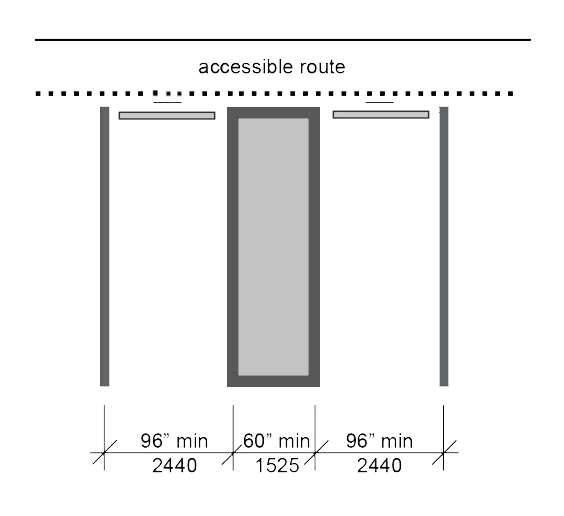
These standard accessible parking spaces must also be painted blue and marked with the International Symbol of Accessibility or placed at a height of at least 60 inches (from the floor to the bottom of the sign).
Van Accessible Parking Space
Van-accessible spaces, sometimes called Type A spaces, include extended lengths and widths to accommodate vans outfitted with ramps or lifts.
These disabled van parking spots are divided into one-sided entry and two-sided entry.
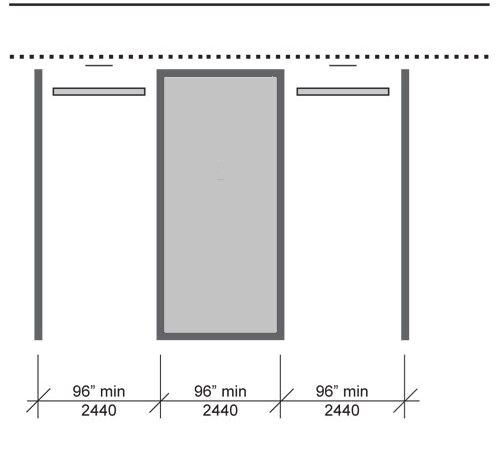
One-Sided Entry: If your van has a ramp or lift installed on the side, you will need a parking spot with a dedicated access aisle on just one side.
Wheelchair users can access and depart a van without moving parked vehicles by lowering a ramp or wheelchair lift into the adjacent access aisle. In this case, the length of the aisle must be at least 96 inches in height and have a maximum slope of 1:49 (2.08%) in both directions.
Two-Side Entry: As for dual-side entry van-accessible parking spaces, they are ideal for larger, full-size wheelchair vans, but they also enable standard wheelchair vans to drive or reverse into a space without worrying about ramp space on either side of the vehicle.
The Americans with Disabilities Act necessitates 132-inch-wide (11-foot) parking spaces with a 60-inch-wide access aisle on both sides. White diagonal lines in the access aisle indicate parking area access and off-limits areas.
Moreover, two signs must be mounted at least 60 inches (measured from the bottom of the sign) above the ground.
- First sign: international symbol of accessibility
- The second sign stating van-accessible parking spots
Remember that the ADA revised its requirements in 2010, and parking spaces constructed before that year may have different standards for the number of spots.
Number Of Accessible Spaces
Depending on the size of the parking lot, the ADA mandates a certain number of accessible parking spaces.
If the parking lot is small enough to require only one accessible parking space, it should be a van-accessible space.
The ADA parking space requirements suggest that there must be one more marked parking spot for every 25 parking spots in a lot. In a parking lot with 150 spots, six places should be set aside for people with disabilities. Regarding parking lots with up to 500 spots, nine areas must be set aside for people with disabilities and two places just for vans.
The chart below shows how many accessible parking spots must be provided based on the lot’s total number of parking spots.
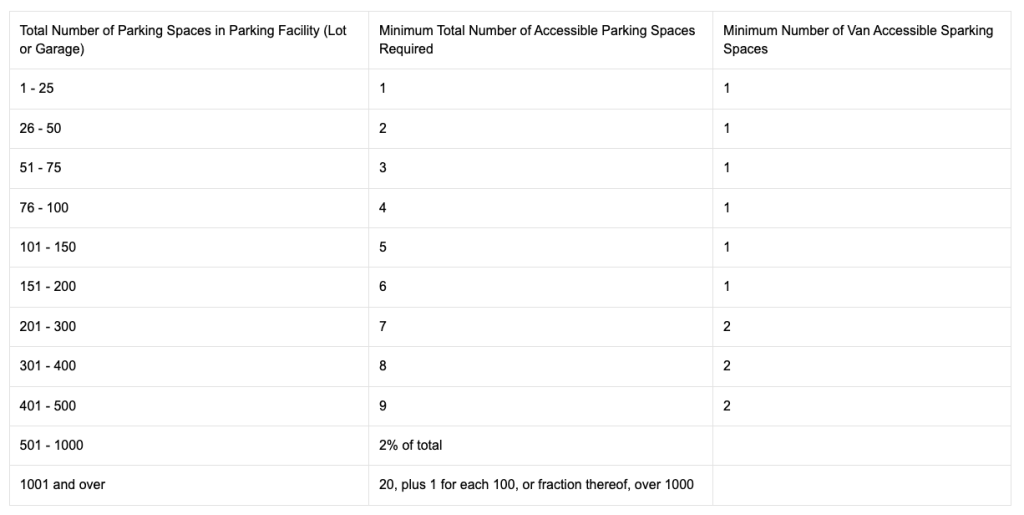
Additionally, one out of every six accessible parking spaces must be van-accessible. For instance, a parking lot with 400 spaces requires eight accessible spaces, of which two must be van-accessible.
Limited Parking Rules
Accessible parking spaces are required in parking lots with four or fewer parking spots. However, regardless of disability, anyone can use them without marking them.
Exception For Medical Facilities
Exceptions should be noted as follows for accessible entrances in medical facilities:
- There should be 10% more accessible parking spots at hospital outpatient facilities and other medical facilities that offer outpatient services.
- Rehabilitation facilities and hospitals that serve patients with mobility impairments or outpatient physical therapy facilities should provide 20% more or separate parking facilities than is typically required.
Parking Rules in Public Places
Additionally, facilities used only by buses, trucks, delivery vehicles, police vehicles, law enforcement vehicles, or car impound lots do not require accessible parking spaces. However, if the public is allowed access (for example, to retrieve an impounded car), a loading zone accessible to people with disabilities must be provided.
Handicap-Accessible Signage
Parking spots designated for the disabled must also have marked signage describing their intended use.
A pole with the International Symbol of Accessibility (ISA) should be installed in all handicapped parking spaces for this purpose.
Usually painted in white, the symbol depicts a person in a wheelchair on a blue background. It is a symbol that everyone has access to all the public places.
These signs must be mounted at least 5 feet (60 inches) above the parking surface to be seen even if a car is parked directly in front of them and must be visible from the vehicle’s driver-side window.
Parking lots with four spaces or less or residential lots where parking spots are designated to specific individuals are the only places where ADA signage standards do not apply and are optional.
Painting the International Symbol of Accessibility
There are a few prerequisites before you can begin painting an accessible parking spot.
Know the Rules
First, painting an accessible parking spot without proper authorization may be unlawful in some communities, such as New York, as parking spots cannot be painted in public places without obtaining the necessary permissions and approvals from the city’s Department of Transportation (DOT). So it’s better to be careful and investigate yours before beginning.
Also, the area to be painted should be entirely dry and free of any obstacles. A leveling agent is recommended if the surface to be painted is not flat.
Space Requirement
To prepare for painting an accessible parking space, its measurements must be measured and marked. The minimum requirements for this area are 96 inches (8 feet) in width and 120 inches (10 feet) in length.
Additionally, the space must be at least 6 inches wide and 18 inches long at the end opposite the parking stall.
Paint Choice
Once everything is ready, the accessible parking spaces may be painted.
Blue for the background and white for the handicapped-accessible symbol are the most popular colors when painting handicapped-accessible surfaces. However, one may also utilize red, yellow, and green. Success will be defined by how well the pavement marks stand out against the background color.
Paint at least 18 inches wide should be used for the marks. Start by outlining the area, then filling in the middle. Before utilizing the room again, make sure the paint has dried thoroughly.
Only in the states of California, New Mexico, Tennessee, and Washington is it mandated by law that the background color of the pavement marker be blue. In Oregon, for example, blue backgrounds for disabled parking places are not required.
Access aisles should be painted with diagonal hatch marks that denote each parking space and contrast with the pavement material to make them restricted parking. Typically, hatch symbols are painted white, or one can use vibrant yellow or white on a black asphalt surface.
Also, house paints do not stick to asphalt or other paints. Parking line paints, whether water-based or oil-based, are formulated specifically for asphalt and concrete and are what professionals must use. The addition of a “No Parking” surface marking is also permissible.
A video showing how accessible spaces are painted with an example of the medical center, signs, and where to park the car.
Maintenance of Accessible Parking Spaces
In addition to compliance with these regulations, a regularly maintained parking lot is critical for its use.
The parking spots designated for the disabled and any adjacent aisles, passageways, or routes should always be kept spotless and in good repair. All broken pavement and holes should be fixed right away. If the paint is rubbed off, repainting is also necessary.
Any obstructions, such as dead leaves, trash, loose stones, ice, dirt, or anything else, must be removed. Maintaining an environment free of hazards in all accessible areas is recommended.
Other Penalties and Rules
The Americans with Disabilities Act (ADA) mandates the above standards to guarantee that public spaces, including parking lots, are accessible to people with all impairments.
Failure to comply with these regulations carries legal consequences, including penalties of $1,500 to $10,000 or more. If adequate parking is not provided, an offense classified as a crime could be undertaken in various states.
A civil violation is given to drivers who occupy accessible parking spots without displaying the required license plate or placard. Depending on where it happens, you might get a parking ticket or be towed.
These are, however, guidelines rather than specific laws. Certain states and city governments may impose additional, more stringent regulations. It is then recommended to check the local laws regarding handicap-accessible parking spaces.
Conclusion
Handicap-accessible spaces are more than a luxury for people with impairments or mobility challenges. By adhering to ADA guidelines and consistently maintaining accessible parking spaces, we can ensure that individuals with disabilities have equal access to the necessary services and facilities.
